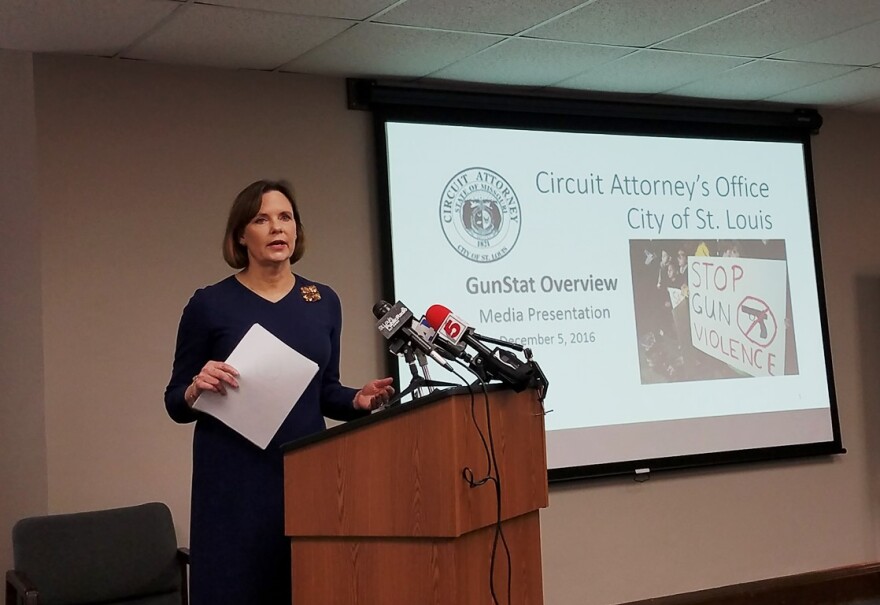In 2015, circuit attorney Jennifer Joyce announced several new initiatives to help combat gun violence. On Monday, she met with the media to discuss whether she thinks those plans are working.
The efforts focused on three main areas:
- Resolve — Making it clear to the community how much the office needs its help to solve gun violence.
- Redirect — Moving low-level or first-time gun offenders out of the criminal justice system through diversion programs or stricter terms of probation.
- Remove — Finding ways to get tougher sentences for those prosecutors consider a real danger to society.
What changes were made?
Prosecutors and homicides
In April 2015, Joyce began sending a homicide prosecutor directly to the scene of a crime. The resulting relationships that developed with witnesses and with homicide detectives mean the office is more frequently filing murder charges, she said, and the cases being presented to juries are much stronger.
"If we've got stronger cases and we're issuing more cases, we're taking murderers off the street. And in the long run, that's going to impact gun crime," Joyce said.
Between 2010 and 2015, prosecutors filed charges in an average of 58 percent of the homicide cases that police brought to them. So far this year, that number has jumped to 81 percent.
Gun dockets and gun diversion
With the help of a federal grant, Joyce launched a diversion program for low-level, first-time gun offenders. If eligible defendants complete the intensive probation-like program, the criminal charge is wiped from their record. So far, 23 defendants have been accepted into the program, and four are in the final phase.
"Let's say each of those 23 people went down the same path we see so many young people go down, and they each shot five people," Joyce said. "Those statistics aren't going to be there now, because we've diverted them."
Gun dockets have been a source of frustration for Joyce and St. Louis Metropolitan Police Chief Sam Dotson since 2013, when the judges of the St. Louis circuit court rejected a plan to assign all gun crimes to one or two judges.
But in 2016, the court decided to take a chance on a modified armed offender docket. Low-level felony cases are handled from start to finish by three dedicated judges, Joyce said. And those judges have taken the charge seriously.
For example, said Joyce's chief trial assistant Beth Orwick, Judge Michael Stelzer has started a check-in docket for the gun defendants he handles.
"A lot of times, if you're on probation and you violate probation, that's the only time you're going to see the judge," Orwick said. "However, with Judge Stelzer, even if you're doing everything right, you still going to need to come in and check in with him."
Though it's very early, Orwick and Joyce say they are pleased with the results of the gun docket. Of the 204 defendants, just 10 — 5 percent — have re-offended.
Is it working?
Crime statistics show mixed results.
Homicides in the city have increases year-over-year since 2012. Aggravated assaults with a gun — a close approximation for shootings — have risen since 2013, though the numbers are down so far this year compared to the same time last year.
"If someone is just looking at crime stats for today in assessing the success of our initiatives, I would say they are looking at the wrong information," Joyce said. "Gun violence is a complex, nuanced problem. There's a million different causes for it and a lot of them are way outside my lane as a prosecutor."
What's up next?
Prosecutors are next turning their attention to charging more people in non-fatal shooting cases.
Between Oct. 2015 and Sept. 2016, police took reports of 821 non-fatal shootings, according to statistics from Joyce's office. But officers sought charges in only 175 of those cases — a closure rate of just 21 percent. By comparison, the closure rates for homicides over the same period was 54 percent.
The lack of prosecution makes gun violence in the city worse, Joyce said.
"If you’re a shooter, you go out and shoot someone, and nothing happens, there’s no consequence for that, what are you going to do the next day? Go out again," she said.
Her office has put together a working group to see how strategies used in homicide cases might be applied to non-fatal shootings.
Joyce said her office is also hoping to evaluate why violent crime is moving west.
The biggest wild card in all of this? Joyce leaves office Dec. 31.
"We've been meeting with Kim Gardner and her transition team about these things," Joyce said. "I'm confident that we've put together a really good foundation for her to build on. And I'm also confident that anybody who is circuit attorney for the city of St. Louis is going to recognize hat gun violence is their number-one problem by a mile."
Follow Rachel on Twitter: @rlippmann







